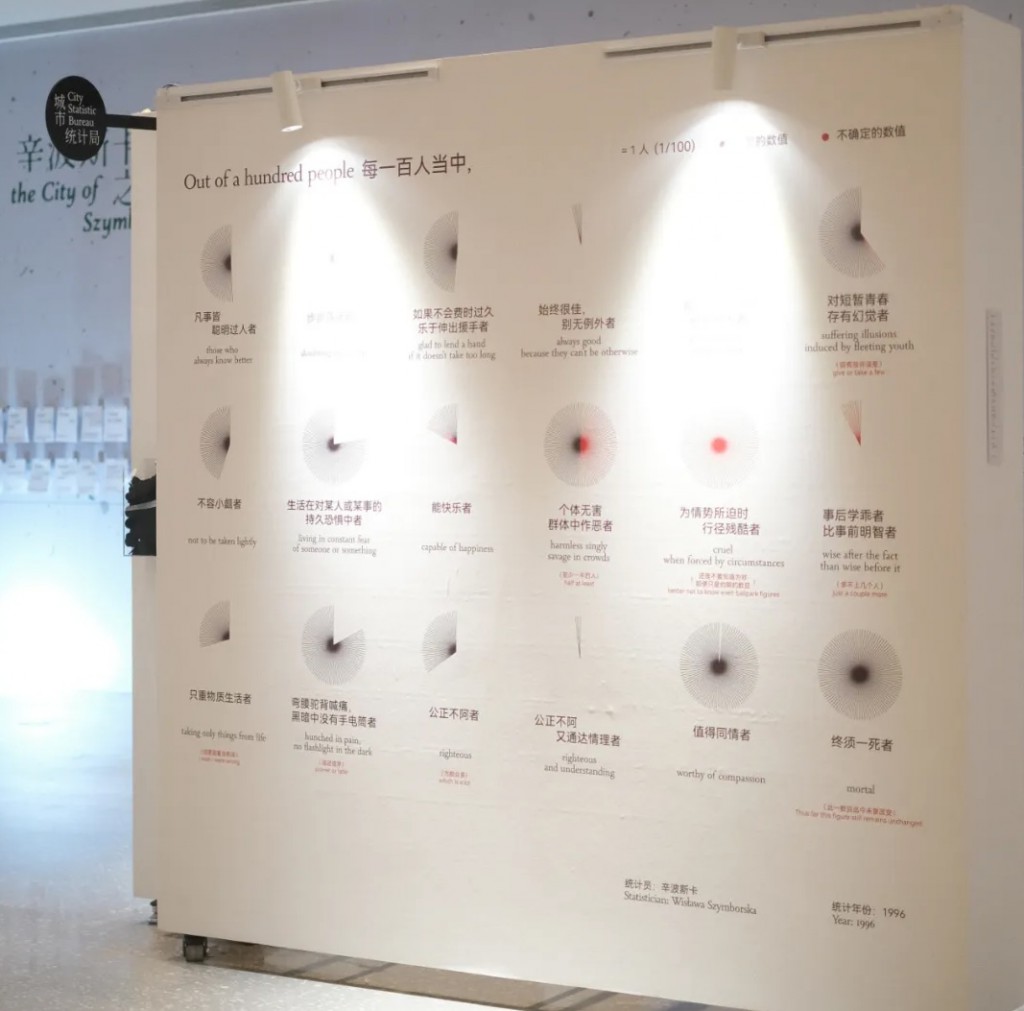In this week of literary updates, we discuss the blend of technology and literature around the globe—from a virtual imagining of the Popul Vuh in Guatemala, to the use of ChatGPT by the winner of a prestigious literary award in Japan, to an interactive exhibition of Wisława Szymborska’s poetry in Shanghai.
Xiao Yue Shan, Blog Editor, reporting for China
Despite having famously said, in an interview with Edward Hirsch, that “it isn’t possible to save mankind”, Wisława Szymborska displayed no shortage of compassion towards humanity and its messes, surging always towards a more enriched penetration into people, the layered fabric of their histories, and the immense variegations of their natures. In China, funnily enough, most people likely became aware of the Polish poet through a celebrated graphic novel by the Taiwanese artist Jimmy Liao;《往左走,往右走》(published in English as A Chance of Sunshine) is a story about destiny and its aloneness—depicting two individuals who walk separate paths but are unified by the same experiences. In it, Liao borrows the following lines from Szymborska’s “Love at First Sight”:
They’re both convinced
that a sudden passion joined them.
Such certainty is beautiful,
but uncertainty is more beautiful still.
That same tension between unity and undeniable difference is consistently offered through Szymborska’s corpus, and is central to a new exhibit in Shanghai centred around her works, held at Qiantan L+Plaza from April 1 to May 15. Composed of interactive installations, performances, and graphic poetic representations, “我偏爱“ (I prefer) is a valiant effort to iterate the complexity of the poet’s exquisite awareness, and aspires towards both a sense of communion and a defense of individuality. True to its vision of dialogic action, as well as honouring literature’s confessional and communicative capacities, there are surveys to fill out, votes to cast, letters to open, and a telephone to pick up.

One piece reconstructs her deceptively capacious “A Word on Statistics”, which begins with: “Out of every hundred people”, and goes on to succinctly perform an attuned, almost playful classification of human qualities, from those who are “capable of happiness” to those who are “led to error by youth”. Captured firstly in the exhibit through circle graphs, the poem is given the irony of calculated data before moving on to its next stage, in which the graphs are replaced by empty, transparent boxes, and everyone is given a small black token by which to vote for a trait that suits them; some cast their piece in “ready to help, if it doesn’t take long”, and some simply opted for “mortal”.
In another corner formation, a stack of pages lay on a shelf under the following instructions: “What do you need to get done? Fill out a request along with the accompanied resume.” Farsically provided by the “Mortality Corporation”, the exhibit intends to remove the distance between our past experiences and our present selves. “Life is long,” another caption states, “but your resume is short.” One is asked to list landscapes, loves, worn-out recollections, dreams. Limited by the form’s narrow margins, the piece hopes that by enforcing parameters on how we choose to define ourselves, we will be reminded of all that cannot possibly be condensed or simplified. Upon completion, the documents are either submitted or destroyed, at the behest of each individual.
Some of the pieces veer quite literal, such as an interpretation of “Advertisement”, in which the poet states from the point of the view of a tranquilizer:
I know how to handle misfortune,
how to take bad news.
I can minimize injustice,
lighten up God’s absence,
or pick the widow’s veil that suits your face.
And in a glass case are lined hundreds and hundreds of small white boxes, each containing two capsules. Open one up and find the concluding lines to the above stanza: “What are you waiting for— / have faith in my chemical compassion.”

There has always been a resistance to artificiality in Szymborska’s work; through poems that caution against anthropocentrism to those that pay monument to music, from the witnessing of devastations to diagnoses of chaos, she has hinted at the outline of some deep order in the system of all things, some insistence of reality and its innate, buried song. It’s strange, then, to see these poems dislocated towards a consciously surreal, winkingly utopic infrastructure of sanitised protocols and manufactured mysteries. Where poetry purists might look upon the strange craftiness of these reinterpreted poems with some reserve, however, the exhibition succeeds in opening up a curious doorway between the questions that these poems pose, and a genuine effort to answer them on behalf of oneself. The poems here are taken beyond their status as literature or art, and offered to the public as suggestions: of where contradictory fates can align, of how language can capture phenomena, and of how sometimes, there is nothing to offer in the face of such metaphysical interrogations—only silence. One cannot help but feel that Szymborska’s singular amalgam of humour, irony, and doubt is honoured here, as stated by the poet herself:
Poetry—
but what is poetry anyway?
More than one rickety answer
has tumbled since that question first was raised.
But I just keep on not knowing, and I cling to that
like a redemptive handrail.
The poem excerpts in this piece are taken from the translations of Clare Cavanagh and Stanislaw Baranczak. Photos are courtesy of Owspace.
Rubén López, Editor-At-Large, reporting for Guatemala
What happens when augmented reality is used to intervene in the Mayan cosmovision? That is the question posed by Adrián Oliva, the Guatemalan who created an interactive experience of the Popol Vuh using augmented reality tools.
The Popol Vuh, or Popol Wuj, is the sacred book of the K’iche’ Maya people, crafted to safeguard the historical memory of a civilization facing the relentless onslaught of colonial invasion initiated by the Spaniards in the late fifteenth century. Through its verses, the Popol Vuh is a piece of deep cultural heritage, encompassing myth, history, and spirituality.
In a stroke of innovative brilliance, Adrián has embarked on a journey to breathe new life into this ancient text, using augmented reality to offer an immersive experience to contemporary audiences. His visual proposal resonates with echoes of the psychedelic aesthetics of the 1970s, but Adrián’s reinterpretation has a serene cadence, similar to a lucid dream.
The resilience of the Popol Vuh—as one of the few texts to withstand the ravages of colonial devastation over five centuries—is a testament to the enduring power of memory and art. In turn, Adrián’s endeavor to employ new tools to interpret the text is a fundamental effort to safeguard the flame of cultural memory from the winds of oblivion.
Bella Creel, Blog Editor, reporting for Japan
The most recent recipient of the Akutagawa Prize, Rie Qudan, wrote her book 東京都同情塔 (The Tokyo Tower of Sympathy) with AI. Well, she wrote parts of her book with AI—specifically, five percent, a figure about which readers both domestic and abroad have had much to say. The implications of using artificial intelligence for award winning literature is a necessary conversation (and sure to draw heads), but one important fact has been left out of most English reportage—that is, that only lines of dialogue for the fictional, in-story AI chatbot “AI-built” were sourced from the real-life ChatGPT.
Qudan explained that, in her personal life, she uses ChatGPT for counsel on topics she feels she cannot bring to anyone else. Her fears are thus processed into bytes of meaning, those bytes of meaning linked to statistically likely responses, and those responses reproduced through the artificial intelligence of a computer. At times, she remarked, the counsel she received was contrary to what she’d expected, and these feelings are shared by the characters in her novel when they “talk” with AI-built. So, one question (Should AI be allowed in literature?) becomes many: by using ChatGPT for the utterances of a fictional chatbot, is Qudan’s work more authentic? Does the use of ChatGPT, with its growing role in so many lives as informant, confidant, and copywriter, enhance her commentary on AI? And finally, to what degree should her use of ChatGPT have been clearly delineated from the start?
In response, novelist Keiichiro Hirano says that we’re in a period of transition. Going forward, he suggests consulting with nominees regarding their use (or non-use) of AI prior to determining eligibility for the prize. At the same time, he argues that anyone who has read Qudan’s work would instantly recognize which lines were produced by ChatGPT; he also suggests that many of those arguing online seem to have not read the book at all.
Throughout our discussion on AI and its role in literature, it is imperative that we continue to ask questions of both the topic at hand and our own positioning. In a recent essay for The New York Times, Noam Chomsky writes that the capacity for moral thinking is just one aspect of the human brain that sets us apart from artificial intelligence—that beyond our faculty for deep and limitless thought, it is our ability to determine right from wrong that allows us to make decisions. However, just as artificial intelligence can write at length without ever crafting its own opinion, our sense of right and wrong can just as easily bring us up short. It is easy to hear what others say (this award-winning book was written with AI!) and simply react. But when the truth is more complex, and the solutions more muddled, it is our responsibility to go beyond the consumption and reproduction of what is already being said—lest we veer too close to artificial intelligence ourselves.
*****
Read more on the Asymptote blog:

